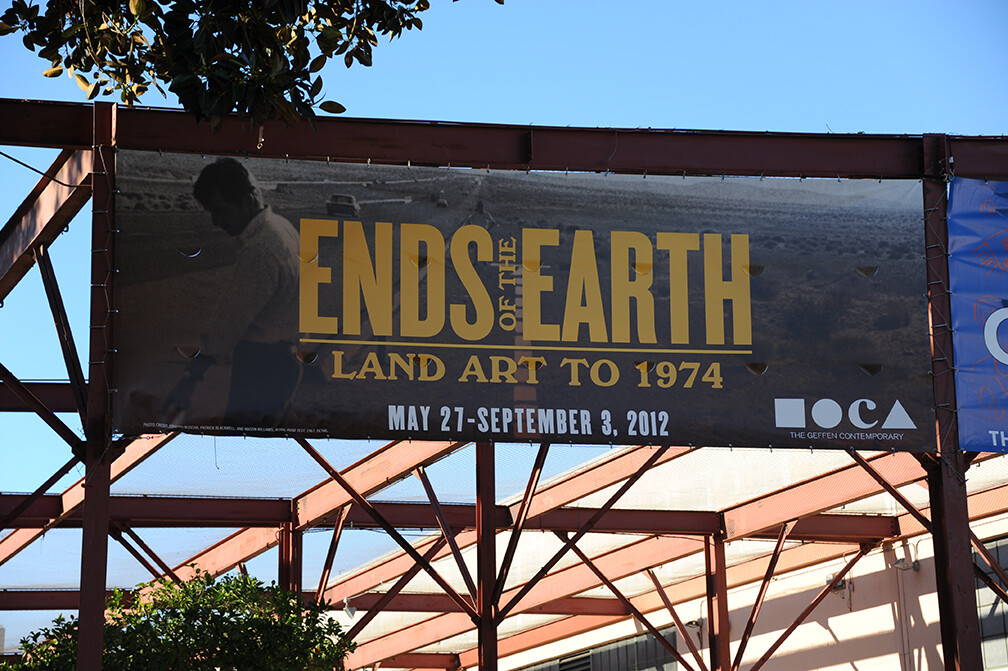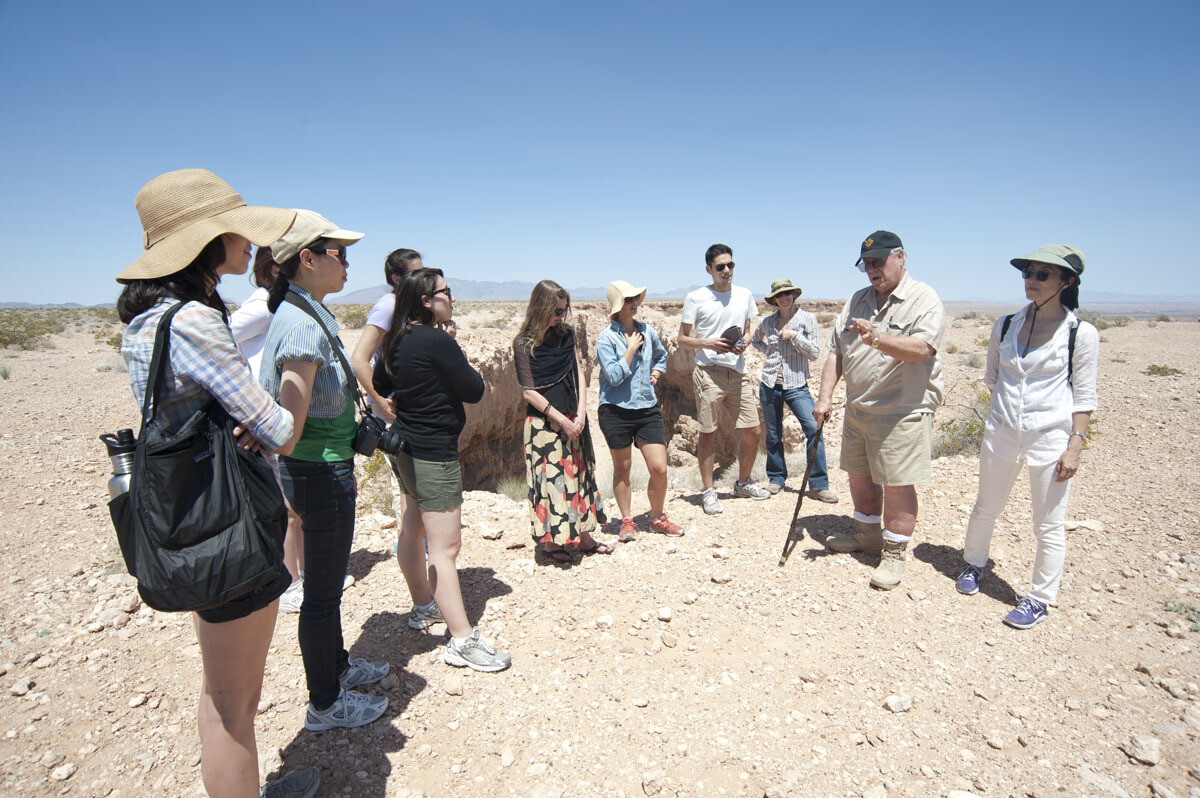A Journey to the Ends of Land Art

LAST APRIL WE were asked to take a group of art history students from UCLA on a trip to visit Double Negative, perhaps one of the most iconic pieces of land art, made by Michael Heizer in 1969.
The trip was to take place around the opening of the exhibit Ends of the Earth: Land Art to 1974, a wide-ranging survey about land art at the Museum of Contemporary Art in Los Angeles. Though more than 80 artists were represented in the show, the two most renowned living “land artists” declined to participate, Walter De Maria and Michael Heizer, whose absence was especially apparent, as he was physically in town alot of the time the show was up, preparing his Levitated Mass sculpture at the Los Angeles County Museum of Art. The other odd discordance was that MOCA actually owns Heizer’s most famous land art work, Double Negative. With these interesting absences and presences, positives and negatives, when asked to do the tour by the co-curator of the exhibit, professor Miwon Kwon, it seemed to us unavoidably inevitable.
We met the class in the morning as they emerged from their hotel at CityCenter, the new urban themed resort in Las Vegas, built by MGM and the Dubai World Investment Group, and the largest privately funded construction project in U.S. history, by some measures. CityCenter is comprised of a cluster of lurching 50 story towers and other buildings designed by the likes of Daniel Libeskind, Cesar Pelli, and Norman Foster, filled with expensive hotels, shops, restaurants, and condominiums, and stocked with semi-public art by the likes of Nancy Rubens and Maya Lin. With great aplomb and bombast, CityCenter forces one to conclude that there is no longer a difference between themed urban space, and actual urban space. It helps to convince one, too, that there is certainly more for us to learn from Las Vegas.
The group set out in three rented SUVs, needed for their high clearance on the roads ahead. At an off-ramp overpass for the new loop highway at the northern fringe of the city, we were joined, as planned, by Count Deiro, and his wife, Countess Joan, who had kindly agreed to speak with us at the Double Negative site, our next stop, another hour down the road, past Overton, and up the edge of Mormon Mesa.
Gathered at Double Negative, the group listened to Count Deiro as he gave his account of his connections to the project. It was Deiro who found this site and arranged for its purchase by the gallerist and land art patron Virginia Dwan, who later gave it to the Museum of Contemporary Art in Los Angeles. Deiro’s photos mostly fill the book published by the museum. It was Deiro who showed Michael Heizer how to use dynamite.
“I want you to go away from here today knowing more about this work than anybody does,” he told us. We also went away knowing more about the remarkable Count Deiro than most people do, and his story provides an interesting cultural context to the piece.
“Michael did not have this piece envisioned–so this is a case where the land, the mass, the environment dictated the impetus behind the artist’s vision–so first he had to have the dirt, before he could envision the idea of taking away, making something out of nothing . . . the dirt came first,” Deiro told us.
Deiro, who also goes by his first name Guido, is an Italian Count. His father was a Hollywood composer and accordian player who was married to Mae West for a time. After his mother remarried a bookie and gambler, Deiro became a mob kid in Las Vegas, and eventually a pit boss at the Sands during the Rat Pack period. He loved flying planes, and ended up developing local airports, doing charters, flying people in and out of Vegas, skywriting, and building up the aviation industry serving the casinos and the growing city.
Soon after the richest man in the world, Howard Hughes, came to town, in 1966, he bought the old main terminal at the airport and hired Deiro to run the local aviation side of the Hughes Tool Company, the original source of Hughes’ personal wealth and the financial conduit for his most ambitious endeavors.
Deiro says Howard Hughes loved airplanes even more than women, and Hughes had big plans for aviation in southern Nevada, including a supersonic transport plane which was going to bring people there from places as far away as Japan in under four hours, opening Las Vegas up to the world. Mormon Mesa, where Double Negative is now, was one of the places Deiro looked at as a possible airport for the supersonic plane. The plan fell through, largely due to environmental and noise concerns (and the fact that Europeans developed the similar Concorde), so Hughes started buying casino hotels and land instead, and Deiro was involved in many of these transactions.
Deiro’s engagement with land art began by a chance meeting. One day in 1968, Geoffrey Gates, a Wall Street financier who had commissioned some of Heizer’s dry lake work (along with work by Robert Scull and others) came by the airport when Deiro was around, looking for someone to help him find Rift 1, one of Heizer’s Nine Nevada Depressions, made in a dry lake earlier that year. Deiro had seen photos of desert land art pieces in Life magazine, and was intrigued. He had a sense of where it might be, and flew him to Jean Dry Lake, landing right next to the piece–a zig-zag trench dug in the dry mud.
“After that Geoff was very enthusiastic about meeting me,” Deiro told us, “and he says, ‘listen I’m going to tell Michael Heizer, and Walter De Maria, and Frank Stella, and Jeffrey Koons, and Virginia Dwan and Heiner Friedrich, and everyone down at Max’s Kansas City about you.’”And sure enough, Deiro soon got calls from some of these New York City-based artists and collectors interested in finding land for sculptures, and was invited to New York to see their work. “I went to the very first sculpture show at Dwan,” he said, “I went to the Guggenheim’s retrospective, I met Dan Flavin, I met everyone, it was wonderful . . . I loved their work, I really did, I got to know them–and they liked me, I wasn’t a competing artist–I was Guido, if you want something go to Guido.”
He worked with Dwan, Charles Ross, Walter De Maria, and Michael Heizer, who he especially got along with. He and Heizer would hang out drinking at the Stardust, making big plans on cocktail napkins (napkins and other things Deiro would later give to the Nevada Museum of Art in Reno, items which became the founding collection for the archives at the museum’s Center for Art + Environment). With some promised resources from Virginia Dwan, Heizer asked Deiro to help him find sculpture sites in southern Nevada. Deiro thought of Mormon Mesa, the potential Hughes SST airport site, and asked a friend who had bought hundreds of acres there thinking that it could be divided into lots and sold to people who had never seen it (a so-called Florida Scam, something that has been done on remote land throughout the southwest as well as Florida). The land he owned covered the edge of the mesa and the undevelopable slopes along its sides. After Deiro flew Heizer over it, Heizer’s vision for a sculpture formed. Deiro bought the land from his friend and transferred it to Virginia Dwan. Then Heizer got to work excavating the crumbling sides of the mesa into Double Negative, starting in late 1969.
Double Negative was made without permits or engineered drawings. The form was blasted out of the living rock over three months by the artist himself, along with a small crew and earth moving equipment. 240,000 tons of earth were ultimately displaced, creating two 30-foot wide trenches hundreds of feet long. Deiro would drop off supplies periodically, including dynamite, but otherwise stayed out of the way. And so it came to pass.
After listening to the Count’s account, and exploring Double Negative, the group left the mesa top for lunch and more stories at Sugar’s Home Plate, a café and bar in Overton favored by bikers. After lunch, we parted ways with the Count and Countess, and continued on our way northward, to look for the site of Las Vegas Piece, an artwork also made in 1969, by Walter De Maria, a friend of Michael Heizer, and the other missing artist from the Ends of the Earth exhibit.
Las Vegas Piece was a geometric etching on the ground, composed of four connected lines, two of them a mile long, and two of them half a mile long, made by scouring a few inches off the top of the rocky soil with the eight foot wide blade of a grader. It’s at a remote site down 35 miles of dirt road from the interstate.
Some would argue that it isn’t there at all, that the piece is gone. Certainly, as originally intended by De Maria, the piece no longer exists, just as “none” of Heizer’s dry lake pieces exist, even if traces can be found. Of course these are ruins of land art, not land art. But for a group of art historians, the interest in going there was not to experience the piece, but to experience the place where the piece was. To understand it better forensically, and archeologically. And to ground truth the land art that usually exists to us only in photographs–to verify its historic existence heuristically.
Only the faintest sense of the lines of Las Vegas Piece is discernable, and barely so enough to leave some unconvinced that they saw it at all–its existence is a matter of interpretation. It’s on the limits of perception, conjured up in the mind’s eye and space by lining up mountain ranges in the background of photographs in art history books with those in the distance of the actual site. In a paralaxed overlay, when the alignment lines up, the viewer descends into the photo at the same time the piece in the photo emerges into the viewer’s live view. You are there, even if it is not.
The following day, after a night on the town at CityCenter, some members of the group visited the Dig This yard, where you can rent time on heavy earth-moving equipment, just like those used to make Double Negative and Las Vegas Piece. For a fee you can dig trenches, make mounds, and move large tires and blocks around for as long as you like. Only here, any land art you make is erased by the next patron. ♦
